Discover top guides, trends, tips and expertise from AIO Writers
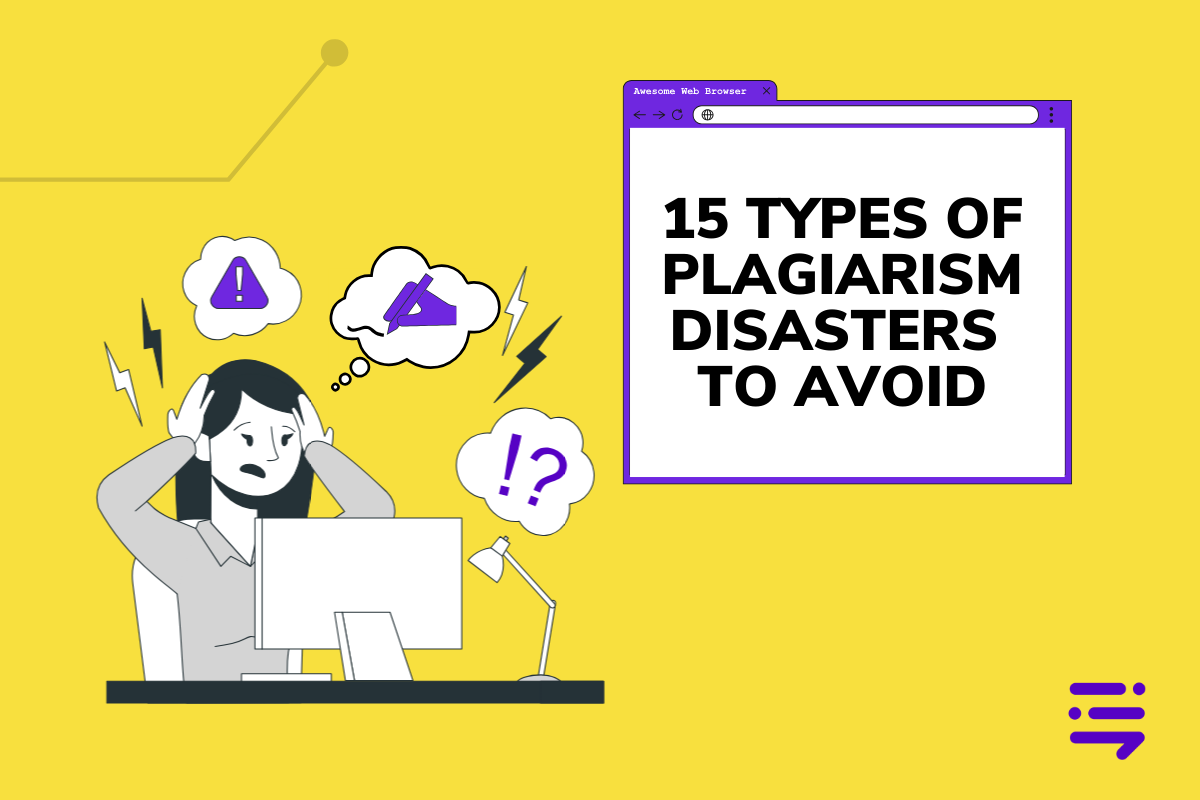
The academic world and the professional writing sphere rely heavily on the concept of originality.
You pour your heart and soul into research, analysis, and crafting arguments. It’s devastating to think about your hard work being copied, rebranded, or worse, passed off as someone else’s.
In this blog post, we’re diving deep into what types of plagiarism exist, from the most common types like direct copying and patchwork plagiarism to covert ones like bibliographic plagiarism and aggregator plagiarism.
Knowing the types of plagiarism is not just about avoiding academic penalties but about respecting intellectual property and upholding ethical writing standards. By understanding these concepts, you’re not just becoming a better student or writer, but a responsible member of the academic and professional community.
Table Of Contents:
- Direct Plagiarism: The Most Egregious Offense
- Self-Plagiarism: Recycling Your Previous Work
- Mosaic Plagiarism: A Patchwork of Borrowed Ideas
- Accidental Plagiarism: A Case of Oversight
- Paraphrasing Plagiarism: A Common Pitfall for Writers
- What Are The Less-Known Types of Plagiarism?
- Why Plagiarism Matters: Understanding the Stakes
- Conclusion
Direct Plagiarism: The Most Egregious Offense
Imagine this: you’re a professor grading papers and you notice two submissions are eerily the same, word for word.
This is direct plagiarism, also known as “clone” plagiarism.
Direct plagiarism involves taking someone else’s work, whether a paragraph, a page, or even the whole darn thing, and presenting it as your own, with zero attribution to the original author.
This is a blatant act of academic dishonesty.
For example, a student submits a term paper on the American Revolution or a researcher submits a scientific study on stem cell transplant. However, large sections are directly copied from a history book or scientific journal without any acknowledgment.
These acts constitute direct plagiarism and are likely to lead to serious consequences such as getting kicked out of school, withdrawal of grant, or termination of employment.
Read more about the implications of plagiarism and what happens if you get caught.
Self-Plagiarism: Recycling Your Previous Work
You might wonder, “Can I plagiarize myself?”
The answer, surprisingly, is yes.
It’s called self-plagiarism or “recycle” plagiarism.
You’ve likely worked hard on your past assignments, and it might seem tempting to reuse those brilliant arguments for new topics. This might appear harmless, but it’s a slippery slope.
For example: you’re a freelance writer with a knack for crafting engaging website copy. You land a new client in a similar industry as a previous one and think, “why not reuse some of that stellar work?”
You might save time, but ultimately, this action devalues the original work, raises ethical questions, and can potentially lead to loss of income — not to mention damage your reputation.
It’s best practice to create fresh, original content for each client and assignment.
Mosaic Plagiarism: A Patchwork of Borrowed Ideas
Mosaic plagiarism, sometimes called “patchwriting”, works the same way.
This form of plagiarism is subtle as it involves stitching together snippets from different sources without proper attribution, creating a seemingly original piece of work.
The telltale sign? The lack of original thought, analysis, and often, incorrect citations.
For example, a student may take passages from various websites, altering a few words or phrases here and there to create a “new” piece of work.
Despite changing a few words, this form of plagiarism lacks original analysis and synthesis of the material.
Always make sure to properly quote and cite any sources you use, even when paraphrasing.
Learn how to paraphrase like a pro in this complete guide.
Accidental Plagiarism: A Case of Oversight
We all make mistakes. We’re human, after all.
Accidental plagiarism isn’t about intentional deception; it often stems from oversight.
Think about those instances when you forgot to properly cite a source in your bibliography or you carelessly copy-pasted information from a website into your notes, leading to potential plagiarism in your paper.
A student rushing to finish an essay might accidentally forget to add quotation marks around a direct quote, making it seem like their own words.
Always review your work diligently before submitting it. Tools like the BrandWell Plagiarism Checker can help spot these errors before they become a problem. These apps scan your text and compare it to a massive database of online and offline sources to find duplicates.
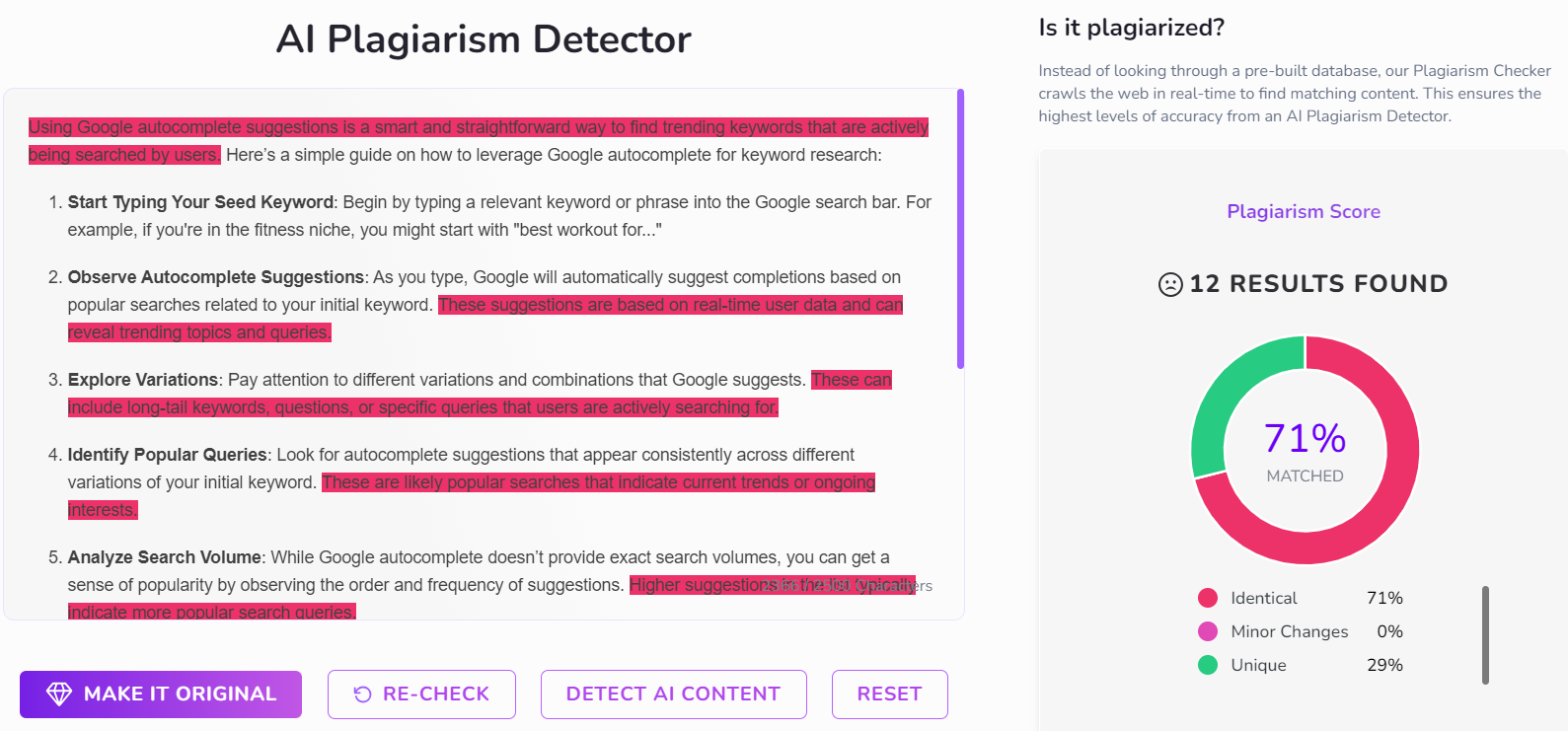
But be extra diligent — these tools are helpers, not fail-safes.
Paraphrasing Plagiarism: A Common Pitfall for Writers
Now let’s talk about paraphrasing — a landmine not just for students who are new to academic writing but even for experienced writers as well.
Paraphrasing itself isn’t plagiarism. It’s an essential tool that involves expressing someone else’s ideas or arguments in your own words while still attributing credit to the original source.
However, things get tricky when paraphrasing borders too closely on the original text.
It is considered plagiarism when you simply replace some words with synonyms or move a few phrases around while keeping the same sentence structure or core ideas as the original source, even with a citation.
To avoid plagiarism, read the material thoroughly and express its main thought in your own vocabulary and sentence structure, all while providing clear attribution to the original author.
What Are The Less-Known Types of Plagiarism?
While the five types of plagiarism I’ve already discussed are relatively well-known, there are more nuanced situations where plagiarism occurs that often go unnoticed — until it’s too late.
The CTRL+C Type
This type of plagiarism happens when someone copies large chunks of text from a single source.
For instance, someone might copy entire paragraphs or pages from a journal article or website without making any changes.
Although they might intend to paraphrase it later, submitting work with such copied content is plagiarism, even if the source is cited.
The Find-Replace Type
As its name suggests, this involves swapping out keywords and phrases from the original source.
While seemingly clever, it’s easily detectable by professors and plagiarism detection software like Turnitin. It’s essentially masking plagiarism by attempting to disguise the original source material.
The Remix
Like a DJ blending tracks, this type involves weaving paraphrased sections from multiple sources, creating a patchwork of borrowed ideas without proper attribution.
Even if sources are cited, the lack of original contribution makes this problematic.
The Hybrid
So you have a properly cited essay. But lurking within are strategically placed, uncited passages.
That’s the hybrid approach, a dangerous mix that blends properly cited work with intentional or unintentional plagiarism.
The 404 Error
Ever clicked a link that led you to a “Page Not Found” message? That’s the core of this type of plagiarism.
Students may create false bibliographies or reference lists with inaccurate citations.
While it might seem harmless, inaccurate citations devalue the academic process and can be construed as a deliberate attempt to mislead.
Related to this type of infraction is bibliographic plagiarism which involves copying the entire bibliography list of another source.
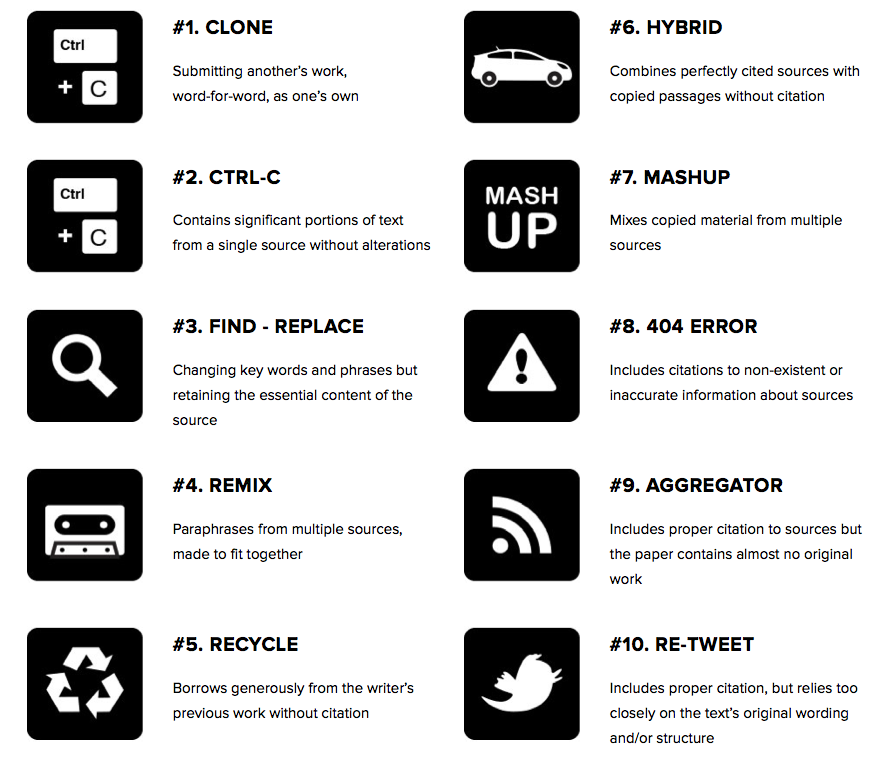
Image Source: St. John’s College Greenfield Library
The Aggregator
Think of this as over-reliance on external sources.
An aggregator paper is chock-full of correct citations but lacks any original thought or analysis.
Imagine an essay where nearly every sentence is a direct quote, properly attributed but with no original contribution.
The Retweet
You probably wouldn’t think twice about retweeting something you agree with. However, within academic writing, “retweeting” involves mirroring the original source’s wording or structure too closely, even with accurate citations.
Remember, over-reliance on the source’s language can detract from demonstrating your understanding of the material. Best to summarize the information and present it in your own words.
The Hired Gun
Hired plagiarism, also known as contract cheating, involves buying an assignment and pretending it’s yours.
This practice is prevalent in academic settings, where students might hire essay mills or freelance writers to complete assignments, essays, or even dissertations.
By doing so, the individual presents the purchased work as their original effort, misleading educators and violating academic integrity policies.
The Collaborator
Collaboration plagiarism occurs when multiple individuals work together on a writing assignment and one of them submits the joint effort as their own without properly acknowledging the contributions of others.
Although teamwork is often encouraged in academic and professional settings, the issue with collaboration plagiarism lies in the misrepresentation of individual effort and contribution. When individuals claim credit for work they did not do alone, it not only misleads evaluators and editors but also undermines the principles of fairness and integrity.
The Outline Thief
Outline plagiarism is the outright copying of the outline or structure of another author without proper attribution.
This form of plagiarism involves taking the organizational plan, headings, subheadings, or sequence of ideas from someone else’s work and presenting it as their original framework.
While the exact wording may differ, the underlying structure remains the same. The original author’s unique approach to presenting ideas is essentially stolen, even if the content itself is paraphrased or rewritten.
Why Plagiarism Matters: Understanding the Stakes
Understanding the different types of plagiarism is critical for several reasons:
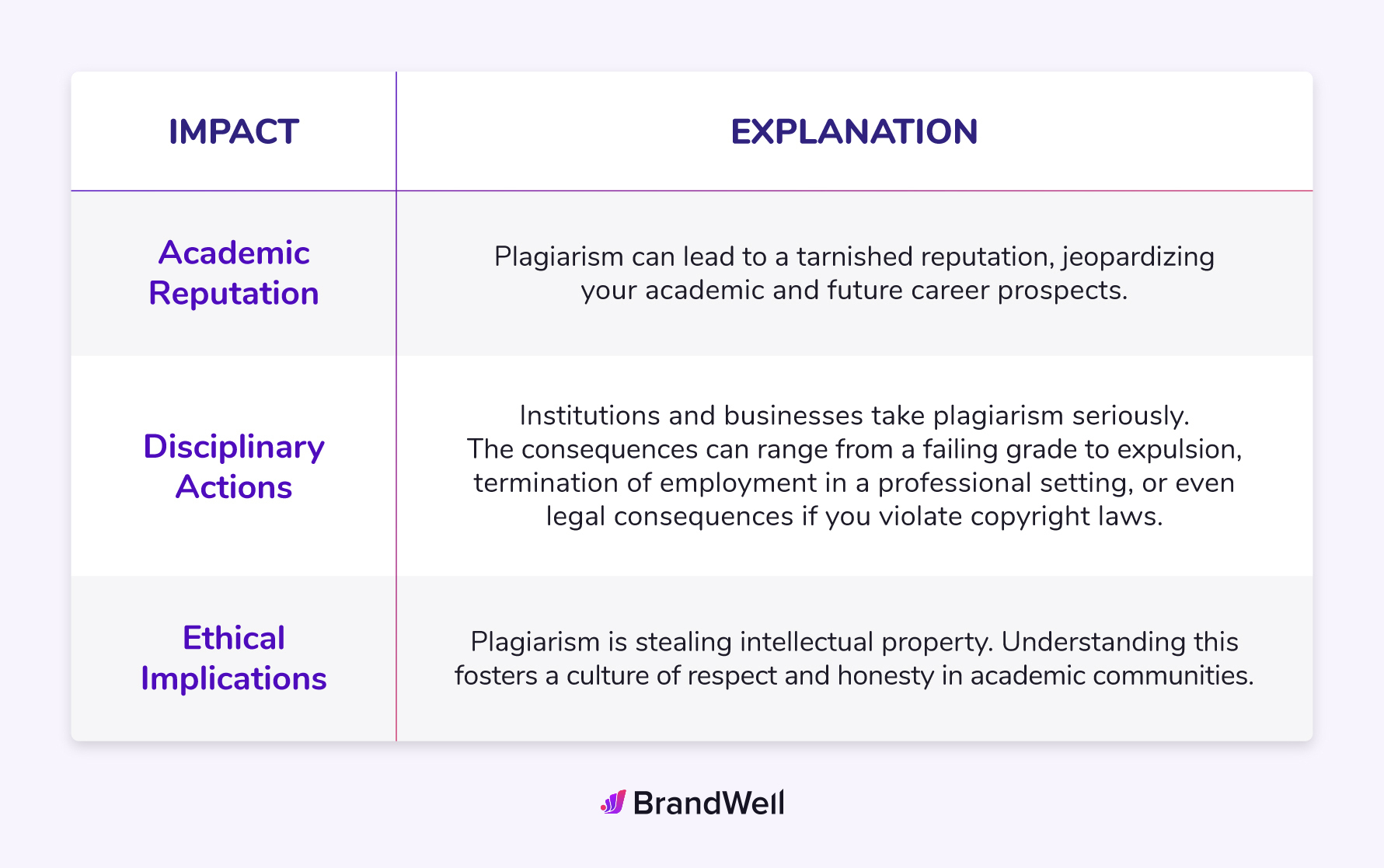
To protect your reputation and avoid the implications of plagiarism, always run your text through a plagiarism detector before submitting it.
BrandWell is one of the best tools out there because 1) it’s free, 2), it’s easy to use, and 3) it offers the most detailed report to help guide you when rephrasing plagiarized content.
Here’s a piece of plagiarized text it spotted from a ChatGPT-written article:
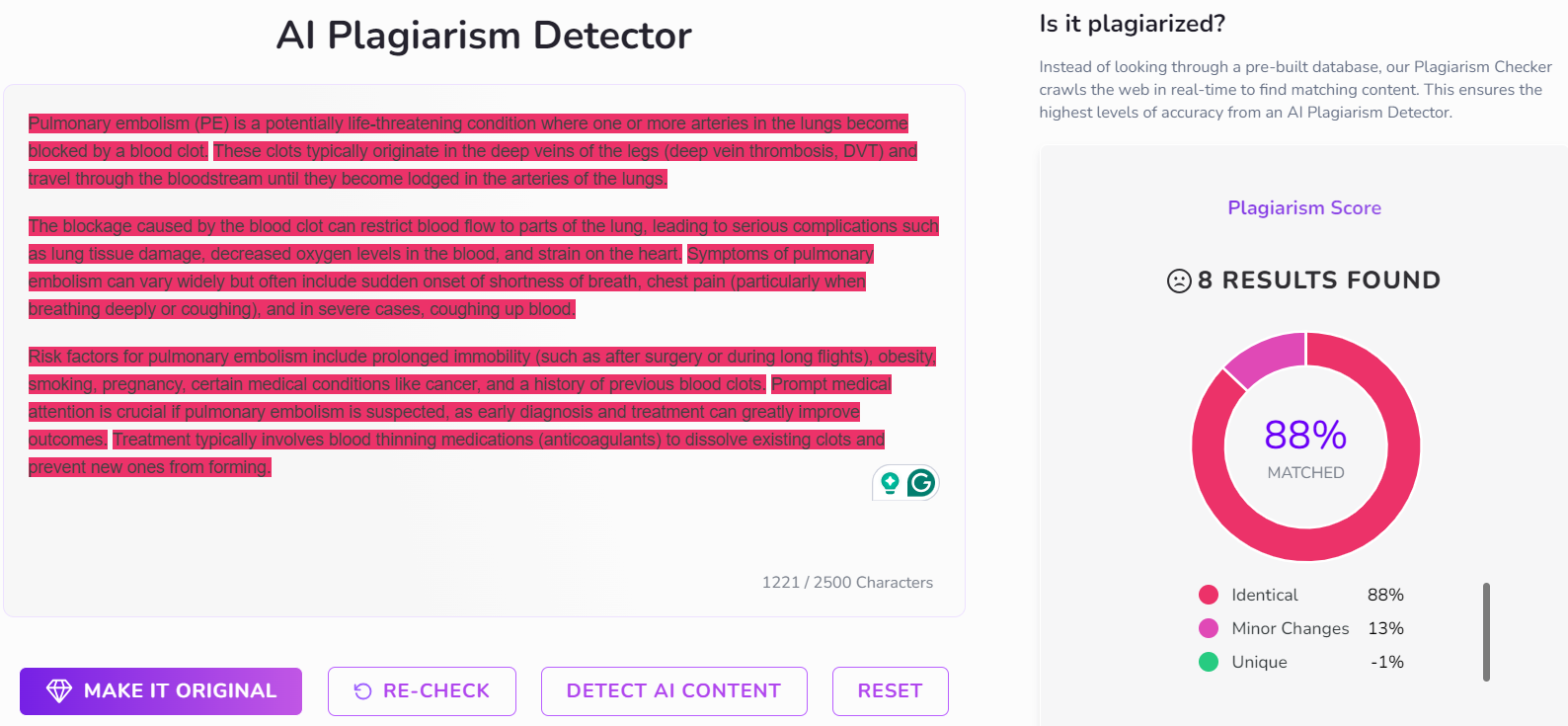
That’s a lot of red 🥵 — which could mean red marks on your paper or a failing grade if you don’t fix those plagiarism issues.
Conclusion
Plagiarism, in its various forms — from the overt act of direct plagiarism to the often unintentional error of accidental plagiarism — poses significant ethical and professional challenges.
Each type involves misrepresenting someone else’s work as your own, whether through piecing together different sources, failing to cite original authors, or copying organizational structures.
Understanding the different types of plagiarism is crucial in both academic and professional settings, where integrity and originality are paramount. To avoid the serious consequences of plagiarism, always attribute sources accurately and develop your own ideas and structures.
Upholding these standards not only fosters trust and respect but also ensures that your achievements are genuinely your own.

UNLOCK YOUR POTENTIAL
Long Headline that highlights Value Proposition of Lead Magnet
Grab a front row seat to our video masterclasses, interviews, case studies, tutorials, and guides.



